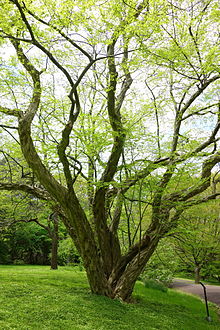| Pteroceltis Temporal range:
| |
|---|---|

| |
| Pteroceltis tatarinowii at the Morris Arboretum | |
| Scientific classification | |
| Kingdom: | Plantae |
| Clade: | Tracheophytes |
| Clade: | Angiosperms |
| Clade: | Eudicots |
| Clade: | Rosids |
| Order: | Rosales |
| Family: | Cannabaceae |
| Genus: | Pteroceltis Maxim. |
| Species[citation needed] | |
Pteroceltis is a genus of small trees in the family Cannabaceae and containing the living species Pteroceltis tatarinowii.[1] The genus is now restricted to an endemic range in China and Mongolia. The genus has a fossil record which includes species described from Korea, Japan, Germany, and the United States.[2]
The fossil record includes one described species from North America, †Pteroceltis knowltoni from the Middle Eocene Cockfield Formation in Tennessee, while an undescribed species is known from the Klondike Mountain Formation of Washington. One late Oligocene species †Pteroceltis tertiaria has been described from strata near Rott, Germany. The largest diversity of fossils are from Asia, with †Pteroceltis shanwangensis from the Miocene Shanwang flora in China, the Abura flora of Japan preserved †Pterocarya ezoana, and both †Pteroceltis taoae plus †Pteroceltis kungshimensis known from the Miocene Hoengyeong Formation in North Korea.[2][3]
References
[edit]- ^ Zhang, Y.; Wang, G.; Zhou, J.; Zhou, X.; Li, P.; Wang, Z. (2019). "The first complete chloroplast genome sequence of Pteroceltis tatarinowii (Ulmaceae), an endangered tertiary relict tree endemic to China". Mitochondrial DNA Part B. 4: 487–488. doi:10.1080/23802359.2018.1544861.
- ^ a b Manchester, S. R.; Chen, Z.D.; Lu, A. M.; Uemura, K. (2009). "Eastern Asian endemic seed plant genera and their paleogeographic history throughout the Northern Hemisphere". Journal of Systematics and Evolution. 47 (1): 1–42. doi:10.1111/j.1759-6831.2009.00001.x. S2CID 84266950.
- ^ Wong, W.; Dilcher, D.; Uemura, K. (2019). "Three new fossil-species of Pteroceltis (Cannabaceae) from East Asia". Phytotaxa. 409 (1): 1–11. doi:10.11646/phytotaxa.409.1.1. S2CID 198254559.
Well, that’s interesting to know that Psilotum nudum are known as whisk ferns. Psilotum nudum is the commoner species of the two. While the P. flaccidum is a rare species and is found in the tropical islands. Both the species are usually epiphytic in habit and grow upon tree ferns. These species may also be terrestrial and grow in humus or in the crevices of the rocks.
View the detailed Guide of Psilotum nudum: Detailed Study Of Psilotum Nudum (Whisk Fern), Classification, Anatomy, Reproduction